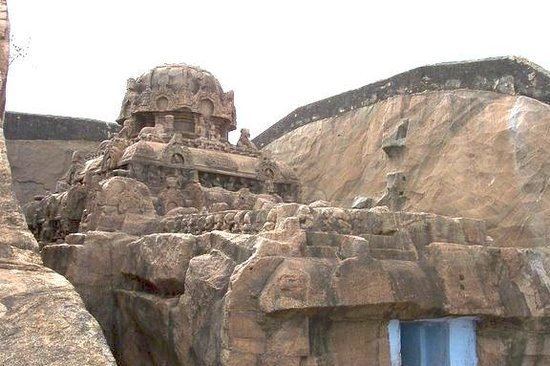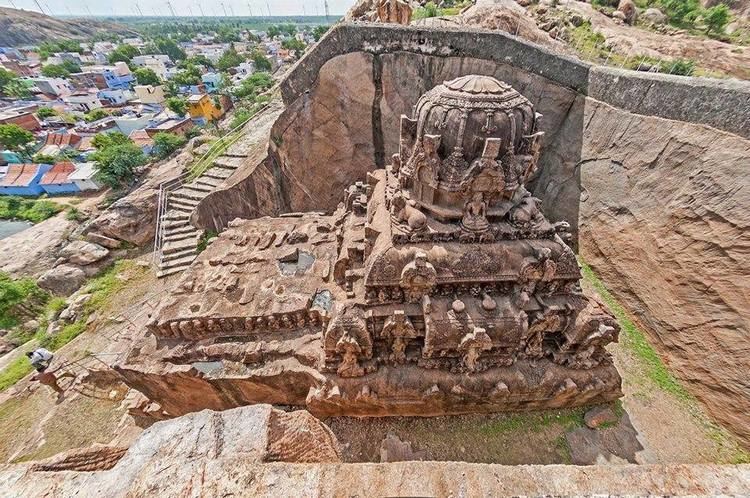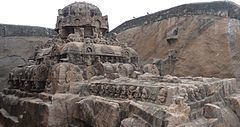 | ||
Website kalugumalaitemple.tnhrce.in | ||
Vettuvan koil kalugumalai thoothukudi tamil nadu india
Vettuvan Koil in Kalugumalai, a panchayat town in Thoothukudi district in the South Indian state of Tamil Nadu, is dedicated to the Hindu god Shiva. Constructed in the Dravidian style of architecture and rock cut architecture, the unfinished temple is believed to have been built during the 8th century by Pandyas. The rock-cut architecture exemplary of early Pandyan Art. The other portions of Kalugumalai houses the 8th century Kalugumalai Jain Beds and Kalugasalamoorthy Temple, a Murugan temple.Vettuvan Koil is the only one of the monolithic Pandya Temple that still survive
Contents

As per local legend, a rivalry between a father and son resulted in son finishing the sculpture first at the lower hills, while the father was slow to respond. In his angst, the father killed the son and thus the shrine remains unfinished.

The temple is maintained and administered by Department of Archaeology of the Government of Tamil Nadu as a protected monument.

Legend

As per local legend, there was a rivalry between a father and son sculptors on who would attain the best specimen. The son started to work on the lower rock for the Murugan shrine, while the father started working uphill. The son claimed that the father would never finish the shrine, which infuriated the father to kill the son. It is believed that the son was able to finish the Murugan temple at the foothills, but the father's work on this temple was incomplete. Another variant of the legend states that the father wanted his son to take time to learn the tricks to start his work. Foregoing the orders of the father, the son started chiselling in the inner chamber. Hearing the sound and raged by the disobedience, the father killed the son. There two literal Tamil meanings to Vettuvan Koil, one of which means "Heaven of sculptors", while the other means the temple of slayer.
History
The temple is believed to have been built during 8th century around 800 AD. The hill was under the control of Ettaiyapuram Zamindar until 1954. The Raja gifted the village to the Kalugasalamoorthy Temple and formed five streets around the temple to enable the temple car to pass easily. He also allocated a middle street for the temple priests. During the Panguni Uthiram festival procession, the elongated conflict between two castes in the region, namely, Nadars and Maravars resulted in a riots, popularly called Kalugumalai riots of 1895. A total of ten people were killed, many injured and the temple car and other property in the region were destroyed. The sculptures in Vettuvan Koil and the Kalugumalai Jain Beds were not affected during the riots.
Architecture
The temple is located in Kalugumalai, a rockyhill in Thoothukudi district in southern Tamil Nadu. The temple is carved out from a single rock in a rectangular portion measuring 7.5 m (25 ft) in depth. The carvings in the temple show the top portion of the temple, with an unfinished bottom. The sculptures and the carvings are indicative of Pandyan art during the period. The granite rock looks like a blooming lotus, with hills surrounding it on three sides. The vimana (ceiling over the sanctum) has niches of Parsavadevatas, the attendant deities of Shiva, like ganas, Dakshinamurthy depicted playing a mridanga, Siva with his consort Uma, dancers, various niches of Nandi (the sacred bull of Shiva) and animals like monkeys and lions. Historian Sivaramamurti believes that this is the only place where Dakshinamurthy is depicted playing the Mridanga (a percussion instrument), while in all other places, he is depicted playing Veena. Epigrapher like V. Vedachalam believes that there is a spontaneity in the sculptures indicating of natural human movements like in the Shiva and Uma sculpture where they seem to be talking like common folks. The other portions of Kalugumalai houses the 8th century Jaina Abode and Kalugasalamoorthy Temple, an unfinished Shiva temple.
Historians have equated the temple with similar temples across India based on the monolithic classification. Historian K.V. Soundara Rajan believes that the temple is similar in architecture to that of Virupaksha Temple at Karnataka by Vikramaditya II during 734-44, Kanchi Kailasanathar Temple built by Narasimhavarman II during 685-705 AD and Kailasa temple, Ellora by Krishna I during 756-77. Some historians believe that the similarities in the architecture are indicative of the political relations between the Pallavas, Rashtrakutas and Chalukyas, which is highly debatable.
Culture
Vettuvan Koil is maintained and administered by Department of Archaeology of the Government of Tamil Nadu as a protected monument. Kalugumalai was chosen in the plan to be included as a rural tourism site in Incredible India campaign by the Tourism Ministry of the Government of India. As a part of the campaign the ministry allocated ₹10 million to develop the infrastructure around the region in 2008. The tourist inflow to the town increased to 3,000 persons per month during 2009 from 400 per month during the previous years.
